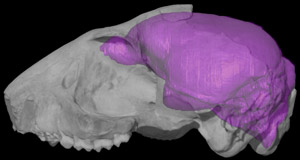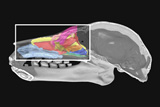 |
|
E.C. Kirk and coauthors have just published a detailed study of the internal cranial anatomy of Rooneyia, a North American Eocene primate of uncertain phylogenetic affinities, in the Journal of Human Evolution. Their analysis suggests that Rooneyia is an advanced stem primate or a basal crown primate. Learn more by reading this newly updated DigiMorph account.
[more...]
|
 |
| Acrotholus audeti, Pachycephalosaur | 2013-05-07 08:46:14 |  |
| In the most recent issue of Nature Communications, Evans and coauthors describe a new taxon of pachycephalosaur, Acrotholus audeti, from the Santonian of Alberta, Canada. They argue that the diversity of small-bodied ornithischian dinosaurs is underestimated, and that taphonomic biases obfuscate the paleoecology and diversity of vertebrate taxa throughout the Mesozoic. Learn more about this new pachycephalosaur -- whose name means 'highest dome' -- by seeing CT imagery of the holotype specimen and reading the DigiMorph account.
[more...] |
 |
| A Nose by Any Other Name… | 2013-03-16 07:40:40 |  |
| A recent paper by Giannini and coauthors examines the internal nasal skeleton of Pteropus lylei, Lyle's flying fox, and compares it to that of other well-known mammals. Detailed study of such delicate, three-dimensionally complex structures was not possible prior to the advent of high-resolution X-ray computed tomography. These researchers found that homologies between these bones -- called turbinals -- are relatively easy to establish across taxa, and thus may be usefully employed in phylogenetic analyses.
[more...] |
 |
| Razorbill Auk, Alca torda | 2012-12-05 16:05:35 |  |
| Charadriiformes is a species-rich, morphologically diverse, and ecologically variable clade of birds, so one might expect that the sensory systems of these birds would be highly variable also. A recent paper by N.A. Smith and J. Clarke examined their endocranial cavity and inner ear morphology and found that the relatively conserved morphology of charadriiform inner ear labyrinths is in stark contrast to the highly variable morphology of their brains. Additionally, this new CT-based research represents the most dense taxon sampling for a comparative endocranial study within Aves to date, and the first attempt at phylogenetically contextualizing potential endocranial apomorphies of an avian subclade.
[more...] |
 |
| Jurassic Chinese Turtles | 2012-10-16 09:40:06 |  |
| In a new book chapter, Brinkman and coauthors describe the turtle fauna of the Jurassic Shishugou Formation of the Junggar Basin, northwestern China. Of the five species occurring there, two can be found on DigiMorph: Xinjiangchelys radiplicatoides and Annemys sp.). These species document early stages in the evolution of the eucryptodire basicranial region, and the diversity of turtles in the Shishugou Formation suggests an unusual paleoecology.
[more...] |
 |
| Eusphyra blochii, Winghead Shark | 2012-09-24 10:03:05 |  |
| OK, so we missed Shark Week, but a bunch of hammerhead sharks are making their way to DigiMorph! The first to arrive is the weirdest of all -- the winghead shark, Eusphyra blochii -- whose head is as wide as half its body length! Why would such a bizarre morphology evolve? Learn about the different theories by reading the expert commentary by Kyle Mara of Temple University.
[more...] |
|
|

